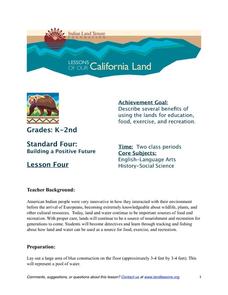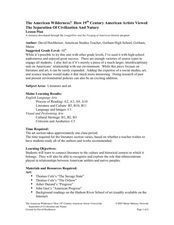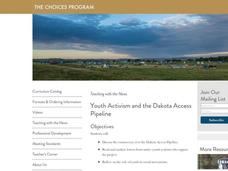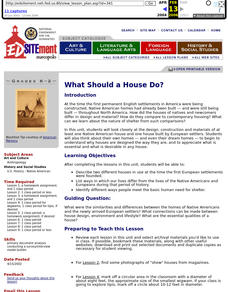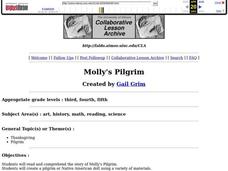Indian Land Tenure Foundation
Gifts from Land and Water
With a series of fun hands-on simulations, young children can learn about conservation and natural resources. Your learners become land detectives, discussing and investigating the gifts that the land and water provide them. They then...
Curated OER
The American Wilderness? How 19th Century American Artists Viewed the Separation of Civilization and Nature
The attitudes of European settlers toward the American wilderness, as reflected in art and literature, is the focus of this resource packet designed for teachers. Included in the unit overview you will find lists or paintings and works...
Los Angeles Unified School District
Why Is the Declaration of Independence Important?
Fair or unfair? To begin a study of the American Revolution, class members review the treatment of the people of the American Colonies by the King of England and decide which were fair and which were unfair. Class members then annotate a...
Curated OER
The Early Peoples
Students, after studying The Early Peoples, explain and give examples of how Native Americans and Europeans adapted to living in certain environments. They give examples of early cultures and settlements that existed in North America...
Channel Islands Film
Lone Woman of San Nicolas Island: Lesson Plan 3
Should researchers be able to excavate, examine, and remove Native American artifacts from historic sites? Should companies be permitted to build on sacred Native American land? After watching West of the West's documentary, The Lone...
Curated OER
Artifact Classification
In this artifact classification worksheet, students are given a list of key terms and two activity sheets about classifying artifacts of the Pee Dee culture. Students analyze artifacts and group them to answer questions on the...
Curated OER
The First Texans
Fourth graders discover the different groups of people who colonized Texas. They research their way of life and create an informative and creative booklet.
Brown University
Youth Activism and the Dakota Access Pipeline
Do young people have a role in social movements? Should they? The involvement of young people in the Dakota Access Pipeline is the focus of a resource that asks class members to examine letters written by native youths who oppose the...
Curated OER
Early Native Americans
Fourth graders locate on a globe where the land bridge was. They describe the progression of nomadic people into North America.
Curated OER
Thanksgiving Mourning
Students examine the way diverse groups can perceive a shared experience in a dramatically different light. Students read commentary written by Native American writers and find examples of different points of view. Students...
Curated OER
Ethnography of the Lewis & Clark Expedition
Young scholars research the people that Lewis and Clark encountered on their expedition. In small groups, they conduct research on a group of Native Americans, answer research questions, and contribute information to a class chart...
Curated OER
The Seasons of Thanks
First graders explain the Native American cyclical concept of time
Curated OER
Whats so Different Between Them
Students evaluate primary sources. In this Westward Expansion lesson plan, students will write essays that compare and contrast the differences and similarities between pioneers and Native Americans. Students will engage in a wide...
Curated OER
Food: Early American Food Cycles Web Quest
Students complete a Web Quest on ways that Native Americans hunted for, harvested, stored, and prepared food and what types of natural foods were eaten. In this early American food cycles lesson, students discover many of the ways early...
Curated OER
Analyzing Primary and Secondary Sources to Assess the Decisions and Policies of Sitting Bull, Red Cloud, and the U.S. Government
Young scholars examine U.S. policies regarding Native Americans. In this Native American history lesson, students analyze provided primary and secondary sources concerning Red Cloud, Sitting Bull, and the Dawes Act. Young scholars use...
Curated OER
What Should a House Do?
Students describe two different houses in use at the time the first European settlements were founded. Students list ways in which our lives differ from the lives of the Native Americans and Europeans during that period of history.
Curated OER
Molly's Pilgrim
Students read the story of Molly's Pilgrim, create a Native American doll, and explore the meaning of the word pilgrim.
Curated OER
Rock Art Stencil Printing
Learners will create a painting using symbols that were used by Native Americans or symbols they create based on what they have learned about symbols used in Native American rock paintings.
Curated OER
The Muskogees
Second graders read a story from their textbook about the Muskogee (Creek) Native American Indian tribe. They discuss various aspects of Native American culture--specifically that of the Muskogee tribe. They explore online resources,...
Curated OER
Rain Dance
Students identify part of the Native American culture and perform a "rain dance".
Curated OER
People of the Plains- Spiritualism
Fourth graders study cultural characteristics regarding Native American beliefs. They discuss spiritualism as it relates to respect. (respect for all things, living and dead; connection with the land, etc.) They provide examples they...
Curated OER
This Land is Ours
Students research and present their findings of the Native American's forced removal in the 19th century. In this Native American lesson plan, students read passages, write and reflect, and look on the internet for evidence of the Native...
Curated OER
Cultural Collision
Students examine the culture of the Native Americans. As a class, they discuss the negative impact of the melting pot theory and how different cultures can be preserved today. In pairs, they practice saying Native American words and...
Curated OER
Lesson plan: History Underfoot
Students study Native Americans of Virginia. In this Virginia history instructional activity, students take on the role of archaeologists as they analyze a site and its artifacts. Students use the information to draw conclusions about...


